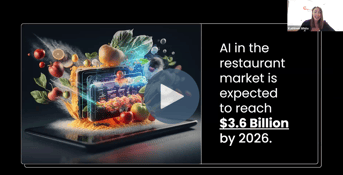Effective inventory management can increase restaurant profitability. But how can you streamline your inventory management strategy without sacrificing the qualities that make your restaurant unique? It all starts with a good, hard look at your menu.
A streamlined menu is the key to a streamlined inventory management strategy. Trimming your menu improves inventory control, lowers food waste, and simplifies execution for overburdened back of house teams. Improved inventory management also makes it easier to keep track of pricing, negotiate with suppliers, and match ingredient orders with real consumer demand.
Restaurant Menus are Getting Shorter and More Focused
“You should be constantly evaluating,” said Sergio Hernandez, director of culinary and business development for recipe software company Meez. “Even before COVID, before today’s supply chain issues, streamlining a menu is something that every restaurant operator should’ve been doing.”
Many competitive restaurants are responding to unpredictable economic conditions by bringing greater strategic control to menu options, portion sizes, and ingredient choices. The result is an industry-wide move toward shorter and more focused menus.
Food-industry market-research firm Datassential reports that more than 60% of restaurants shortened their menus in 2021. That trend has only intensified in the last several years as restaurants look for ways to improve efficiency in the wake of relentlessly rising costs. Many are finding that a tighter menu can increase restaurant profitability.
But it’s also important to make menu decisions that are rooted in data. The goal isn’t simply to shrink your menu. The goal is to streamline your menu for maximum performance.
Factors To Consider When Streamlining Your Menu
So how exactly can you streamline your menu to increase restaurant profitability? There are a number of key factors that drive inventory management for restaurants, including sales, food costs, profit margins, and the way that you use certain ingredients.
Take the following factors into consideration as you refine your restaurant menu and streamline your inventory management strategy:
Compare food costs to food sales
Each dish on your menu carries its own unique profit margin. Your first step must be to analyze the difference between what you’re spending and what you’re pulling in on each and every dish.
“Do the math to see how many units you’re selling each night against the food cost on that dish, and then get an average of a couple of weeks’ worth of data,” said Hernandez. “Then you can decide, is that item making you the revenue that you need based on your total sales?”
Weigh the popularity and profitability of each dish
The other side of profit margin is popularity. Some of your low-margin dishes may also be among your most popular. Certain dishes may even play an important role in drawing people to your restaurant.
“Even if the margin is low, if it’s a signature dish, it might be what you call in the industry as a ‘loss leader’ – you're not making a prime margin but the dish received press and people are buzzing about it,” Hernandez said. “That’s important to weigh after analyzing how it's performing financially.”
Your objective should be to achieve a balance between the dishes that offer maximum profitability and the dishes that drive your restaurant’s identity and reputation. Inventory management for restaurants can be instructive to this process, helping you pinpoint the dishes that drive sales, the dishes that drive profits, and the dishes that can be eliminated.
Rate the versatility of your ingredient choices
You may also be able to improve the profit margins on your most popular dishes with just a few clever recipe tweaks.
“Slight changes in portion size, price, or recipe might push a very popular dish over the edge to also becoming very profitable,” said Geert Merckaert, communications manager at restaurant management software company Apicbase.
You can also lower your recipe costs by taking steps like maximizing the cross-utilization of ingredients in multiple dishes and minimizing your dependence on seasonal ingredients.
“You want ingredients to be versatile,” said Merckaert.“If you have to keep a stock of fresh goods or spices for just a couple of dishes, you run the risk of spoilage.”
When you streamline your menu, you minimize food waste, which is essential to increasing restaurant profitability. Request vendor reports and take a deeper look at how your restaurant is spending its ingredient budget. Incorporate these inputs into your inventory management strategy and identify ways to trim your spend on ingredients without sacrificing quality or consistency.
Ready to Streamline Your Menu?
Emergent technology is helping to streamline and improve inventory management for restaurants. Over the last several years, food costs, supply chain issues, and unexpected closures have made it more difficult than ever to do the math by hand.
You need real-time pricing, refined data, and somebody with the expertise to help you leverage both. To learn more, schedule a free discovery session with one of our experts today.





